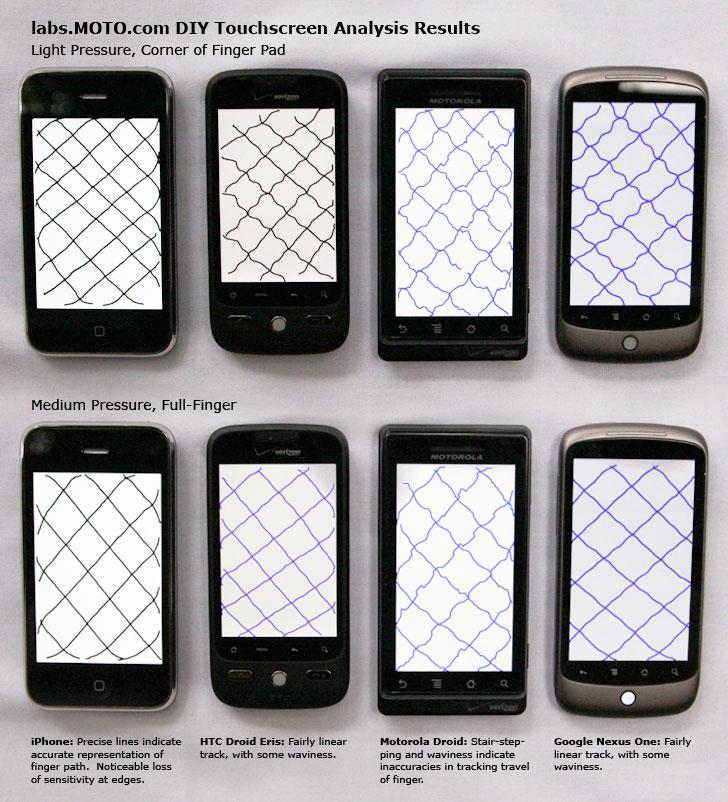The results, published by MOTO labs, noted that the company (which has no relation to Motorola) "has years of experience developing products that use capacitive touch, and we’ve had the opportunity to test many of the latest devices. Our conclusion: All touchscreens are not created not equal."
To demonstrate the differences, MOTO developed a simple test applying finger pressure across the screen using a drawing app. Accurate touchscreen performance comes from a variety of factors, the company reported, noting that screen sensitivity is a combination of hardware component quality and design and software integration.
Under light pressure, the iPhone passed the test with straight, unbroken lines, with only a loss in sensitivity occurring at the extreme edges of the device. The Droid Eris, Nexus One and Droid all experienced stair-stepping accuracy problems.
"On inferior touchscreens, it’s basically impossible to draw straight lines," MOTO reports. "Instead, the lines look jagged or zig-zag, no matter how slowly you go, because the sensor size is too big, the touch-sampling rate is too low, and/or the algorithms that convert gestures into images are too non-linear to faithfully represent user inputs."
"This is important," MOTO explained, "because quick keyboard use and light flicks on the screen really push the limits of the touch panel’s ability to sense."
One user commenting on the results wrote, "accuracy does matter, as anyone who has used a Droid vs an iPhone can tell you. It is much easier to accurately touch small HTML links on the iPhone than the Droid without zooming in, as one example. One can definitely feel the difference in everyday use in the greater accuracy the iPhone has over other touchscreen phones."
 Prince McLean
Prince McLean








 Charles Martin
Charles Martin
 Malcolm Owen
Malcolm Owen
 William Gallagher
William Gallagher

 Christine McKee
Christine McKee
 Wesley Hilliard
Wesley Hilliard

 Andrew Orr
Andrew Orr







56 Comments
Good to see these things that can’t be easily stated on a spec sheet quantified to some degree.
I wonder how the Palm Pre would do in this test?
Just shows Apples attention to the user experience, they want it so streamlined and fluid. The rumored tablet is lookin to knock us on our ass again, deja vu back to 07.
Having both used Droids and owning an iPhone, I can totally support this article. My mothers Droid's touchscreen was a pain to work with, nothing felt fluid or accurate, and fast motions never translated well.
Just reaffirms my belief that no matter how fast, advanced, cutting-edge, etc. the hardware may be, it's of absolutely no use if the software is not up to snuff. Vice versa as well. It's what the other manufacturers just refuse to acknowledge in their path to out-do Apple.
I'm Apple all the way but to some people other functionality might be more important than precise touch 100% all of the time. i.e. multiple open apps, printing, blah blah blah.
Unless your doing a lot of text I don't see pin point accuracy being that important. Maybe if you want to quickly hide the boobs photo from your boss and accidentally load a shlong shot.